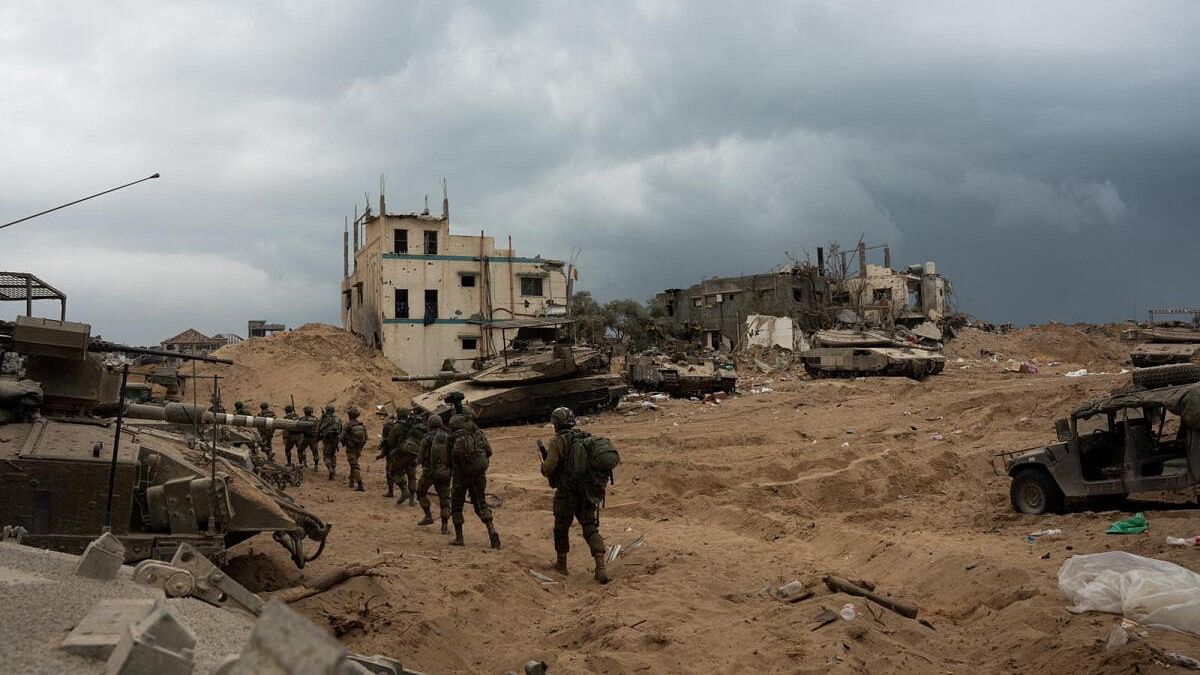
Israeli soldiers operate in the Gaza Strip, amid the ongoing ground operation of the Israeli army against the Palestinian Islamist group Hamas.
Credit: Reuters Photo
The Israeli military on Tuesday pressed its offensive in the southern Gaza Strip, where its troops appeared to be closing in on the main city, Khan Younis, amid growing concerns that there is almost nowhere left for civilians to flee.
In the days since the collapse of a seven-day truce, Biden administration officials have said they had warned Israel to work harder to avoid harming civilians in Gaza than it did in the war's early weeks, and that Israel's military appeared to be heeding that advice.
But more than 300 people were killed in Gaza each day between Saturday and Monday, according to figures released by health officials in Gaza, a daily toll that resembled those from the earlier weeks of the war. The U.N. humanitarian office said that the period from Sunday to Monday afternoon "saw some of the heaviest shelling in Gaza so far."
Two experts in the laws of war said they had not seen significant changes in recent days in how Israel was waging its war in Gaza, largely because its warnings to civilians to move out of harm's way appeared ineffective and the scope of its campaign made it unclear if anywhere in Gaza was truly safe.
"I don't have the sense that the renewed Israeli operations are significantly different than the earlier operations in terms of seeking to minimize the risk of harm to civilians," said Brian Finucane, a former legal adviser at the State Department and now a senior adviser for the U.S. program at the International Crisis Group.
Since Israel resumed its bombing campaign, with a new focus on southern Gaza, much of its new effort to protect civilians revolves around its publication Friday of an online map that divides Gaza into hundreds of tiny sectors. In the days since, military officials have posted on social media about which sectors people need to evacuate and where they should go.
Matthew Miller, a State Department spokesperson, said Monday that while it was too early to make definitive assessments, the United States saw signs that Israel was implementing changes the two sides had discussed to limit civilian casualties, including reducing mass displacement.
Before Israeli forces invaded northern Gaza in late October, Miller said, they issued a blanket order for the northern region -- which had been home to more than 1 million people -- to evacuate their homes. The publication of the map represented "a much more targeted request for evacuations" that was "an improvement on what's happened before."
But the evacuation orders have confused Palestinians in Gaza, many of whom cannot access the map or Israel's posted instructions because they have no electricity and poor to nonexistent internet and cellphone service. Some who have followed the orders have found themselves in already overcrowded areas without shelter or toilets.
Omar Shakir, the Israel and Palestine director at Human Rights Watch, said that warnings were an important way to protect civilians from armed conflict and that a more precise map was more helpful in principle than broad evacuation orders. But he said Israel's new system was not much better that what had preceded it.
"There is no reliably safe way to go and no reliably safe place in Gaza, period, so even if they tell you this area is relatively safe, the airstrikes continue to hit virtually all parts of Gaza," he said.
Also endangering civilians, Shakir said, was Israel's continued use of bombs and heavy artillery in densely populated areas, a tactic under which "the risk of civilian death is amplified." In addition, he said, Israel was still bringing down entire apartment blocks without making clear what the military objectives of such strikes were.
Israel has said that its war seeks to destroy Hamas and that its forces make great efforts to protect civilians. It blames the extent of destruction in Gaza on Hamas, saying its fighters mix in with the civilian population, effectively using them as human shields, and fight from civilian areas.
The health authorities in Gaza say that more than 15,000 people have been killed since the start of the war. While they do not distinguish between civilians and fighters, they say that most of the dead are women and children.
Speaking in Dubai, United Arab Emirates, on Saturday, Vice President Kamala Harris was pointed in urging restraint by Israeli forces, though she declined to say whether she thought that Israel was following U.S. guidance to fight with greater precision to avoid harming civilians.
"But I will say that we have been very clear about where we stand on this, which is innocent civilian lives should not be intentionally targeted, and that Israel must do more to protect innocent life," she said.